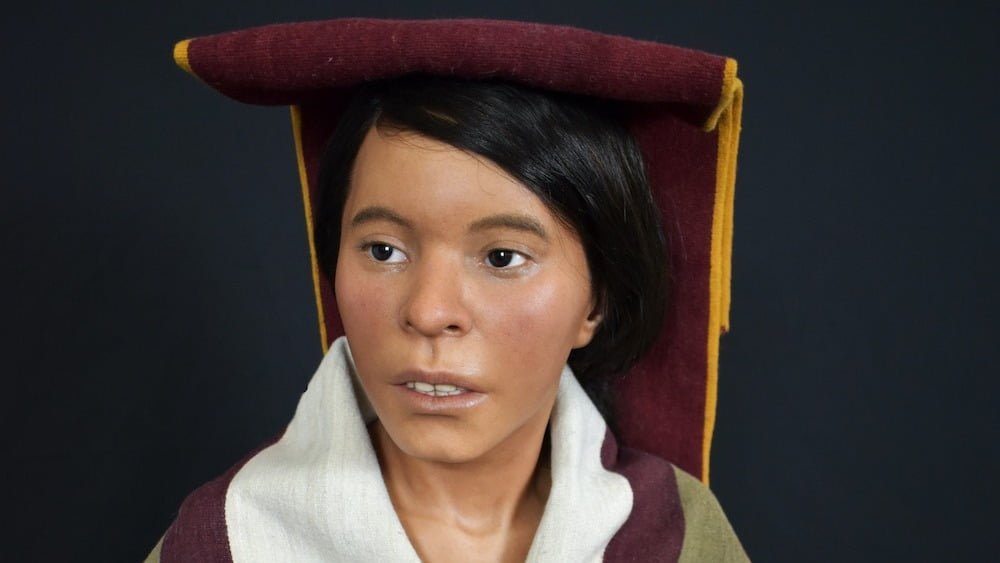Over 500 years ago, high in the Andes Mountains in present-day Peru, an Incan girl met a tragic end as part of a sacrificial ritual. The frozen mummified remains of this adolescent, known as the “Inca Ice Maiden” or “Juanita,” were discovered in 1995 by American archaeologist Johan Reinhard and Peruvian mountaineer Miguel Zárate during an expedition to the Ampato volcano.
 The silicone bust showcases Juanita’s high cheekbones, dark hair, and eyes. Credit: Dagmara Socha
The silicone bust showcases Juanita’s high cheekbones, dark hair, and eyes. Credit: Dagmara Socha
The recent unveiling of a lifelike silicone bust of Juanita’s face was created by Swedish forensic artist Oscar Nilsson in collaboration with the Center for Andean Studies at the University of Warsaw and Museo Santuarios Andinosto in Cuzco.
The reconstruction is part of an exhibition at the Andean Sanctuaries Museum in Peru called “Capacocha, following the Inca Divinities,” at the Andean Sanctuaries Museum in Peru. The exhibition not only presents the recreated visage but also explores the in-depth research conducted on Juanita’s life.
Nilsson utilized computed tomography (CT) scans, skull measurements, and DNA analysis to meticulously reconstruct the facial features of Juanita, shedding light on the appearance of this Incan teenager.
Juanita’s discovery at an alтιтude of 6,400 meters revealed her adorned in ceremonial attire, including a tunic and headpiece, surrounded by gold and silver figurines, woven bags, pottery, and a shell. A CT scan of her skull exposed evidence of a severe blow to the back of her head, leading archaeologists to conclude that she likely perished as part of a sacrificial ritual.
The reconstruction process began with CT scans of Juanita’s skull and body, providing a foundation for a 3D-printed replica. Nilsson meticulously considered factors such as age, gender, ethnicity, and weight to determine tissue depth. He then crafted a clay model, focusing on specific facial details drawn from measurements of her nasal cavity, eye orbits, and teeth. The final step involved casting the face in silicone, incorporating real human hair and pigmenting the skin to match her DNA-derived complexion.
Johan Reinhard, the American archaeologist who found Juanita, reflecting on the emotional impact of seeing Juanita’s reconstructed face, told the BBC, “I thought I’d never know what her face looked like when she was alive. Now, 28 years later, this has become a reality thanks to Oscar Nilsson’s reconstruction.”
 Juanita was killed by blunt trauma between 1440 and 1480, when she was approximately 12–15 years old. Credit: Martine, via Flickr, CC BY NC 2.0
Juanita was killed by blunt trauma between 1440 and 1480, when she was approximately 12–15 years old. Credit: Martine, via Flickr, CC BY NC 2.0
Archaeologists believe Juanita was sacrificed during the Inca ritual called “capacocha,” which often involved children and animals offered to the gods. The sacrifice aimed to address natural disasters, consolidate state power, or seek favor from deities.
Reinhard emphasized the honor Juanita’s community likely bestowed upon her selection, as sacrificial acts were viewed as bringing prestige to the parents and ensuring an afterlife of bliss for the victims.
Research into Juanita’s life continues, with investigations into her diet and the significance of objects found alongside her, including ceremonial clothing, ceramic items, and gold and silver figurines.
Researchers, including Dr. Dagmara Socha, a bioarchaeologist at the University of Warsaw and curator of the exhibit, emphasize the importance of scientific research and facial reconstruction in restoring the idenтιтy of these mummies.





